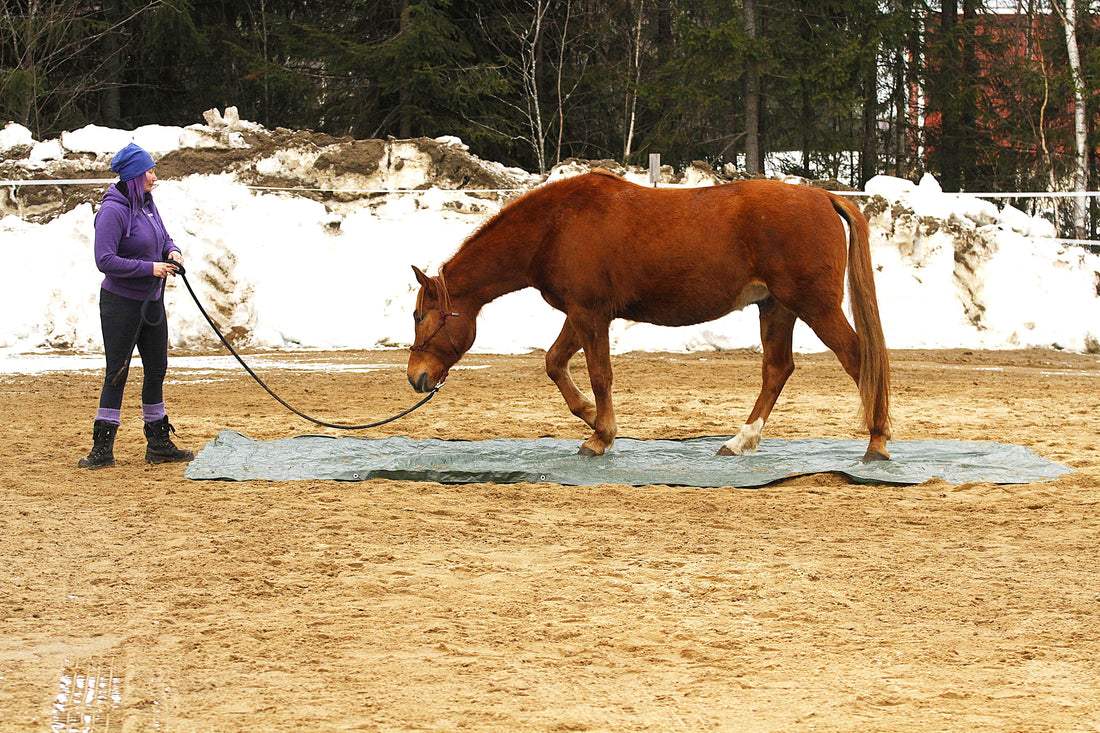
"He is just traumatized mentally."
Written by horse trainer and rehabilitator Mervi Pakola. Photos by Tarja Kivirinta.
If a horse has been in really bad hands and it can be called a case of animal cruelty, people often think that the horse has mental trauma. That's what would happen to us humans. I think this humanizes horses easily too much and horse's pain behavior is mistaken as a mental problem, even if it is a physical problem that can be treated.
I prefer to call mental traumas fear conditioning, which I think describes it better. I have thought a lot about what distinguishes pain behavior from fear conditioning or so-called mental trauma. In my own experience, fear conditioning is very clearly related to a specific situation.
For example, if a horse has been frightened by a carriage, he might be afraid of putting the carriage behind him or even seeing those. If a horse is in pain, his brain's fear system may have been activated, making it particularly fearful in general. Sometimes it is difficult to distinguish between the two.
It may also be that the horse is afraid of, for example, putting a saddle on its back because it causes pain. Either directly caused by the pressure caused by an unsuitable saddle, or just suitable saddle or saddle girth, or by the movement that follows, in which case the horse may start to react to saddling. In this case, it is not necessarily a fear conditioning from something previous, but rather the pain or discomfort of the moment.

Why is it worth having a horse that has been in bad hands thoroughly examined by a veterinarian?
If a horse has been in really bad hands, it is very possible that he has pain somewhere. This is because poor conditions and incompetent or too strong handling creates stress, which in turn exposes him to various problems, such as stomach ulcers. The risk of stomach ulcers is also increased by too long pauses between hay feeding, which may well be the case in a places where the horse's well-being is not properly taken care of. Worms and intestinal infections are also possible due to poor worming or, for example, moldy or otherwise unsuitable hay for the horse.
In addition, in such circumstances, pain behavior is hardly understood, which means that pain remains untreated and the horse can suffer from pain for a long time. Injuries and ailments are not treated as well as they should, so the pain can become prolonged and start to cause problems elsewhere in the body.
Hooves or teeth can be untreated and cause pain if not cared for regularly and by a trained professional. Over time, these can also affect other parts of the horse's body, causing pain and potentially other problems, such as inflammation, soft tissue injuries, etc. Poor hoof alignment can eventually lead to osteoarthritis, which cannot be corrected, although the pain can be treated.
Therefore, instead of thinking that a horse that has been in bad hands is mentally traumatized, it is really important to examine and treat the horse with a veterinarian who specializes in horses. Once the pain is treated, the horse's behavior will likely be much better and you can start to train away fear conditioning, if any are still detected.

So what should you at least do?
I don't think a basic health check is enough. I would at least have a lameness test done on such a horse, which would also take into account the health of the back and do an endoscopy for the stomach. If nothing is found, the price tag for the tests alone is not impossible. For example, at the clinic we use, 550€-600€. If there is something to be treated, then add treatments to the price.
At the same time, it would of course be worth checking the teeth, which are one of the first things that are many times left uncared for. At home, I would call a qualified farrier to treat the hooves as quickly as possible, and I would do a worm egg analysis on the manure and deworm the horse based on the results, following the veterinarian's instructions.
I would keep the feeding simple, even though the horse's weight should be increased. If the cause of the thinness is food allergies, stomach ulcers or enteritis rather than a lack of food, a strong concentrate feed would worsen the situation and I would like to avoid it. I would base the feeding on good quality hay, minerals, salt and possibly add hay pellets, oil, molasses clippings or other generally well-tolerated feed.
If the horse continues to show behavior that could mean pain after a few months of good care, and the initial tests have not found anything to explain it, I would reconsider and have the horse examined by a veterinarian who specializes in horses. At this point, I would know the horse better and be able to explain the pain behavior to the veterinarian more clearly, which would make it easier to find the cause of the pain.
You can use our Equine Pain Finder tool to help you assess your horse's pain behavior. It will also provide you with a list of behaviors that indicate pain in your horse. Showing this list to your veterinarian can help them pinpoint the cause of the pain more quickly.
In my opinion, with a horse that has been poorly cared for, you need to be especially careful about monitoring pain behavior and treating the pain.
